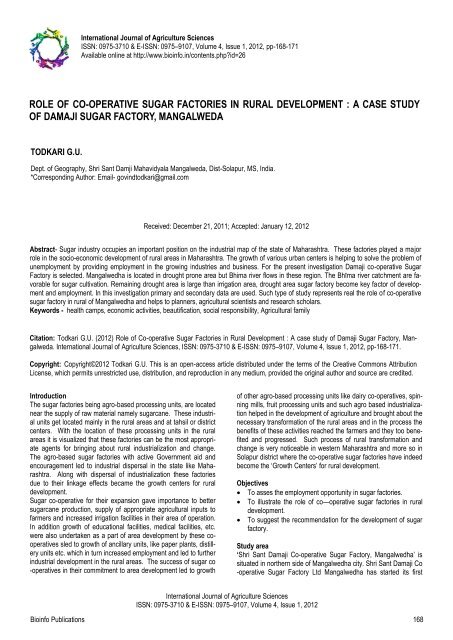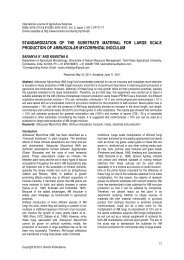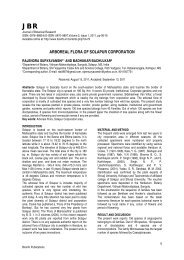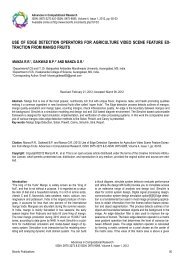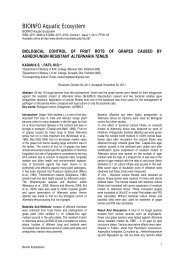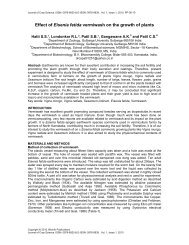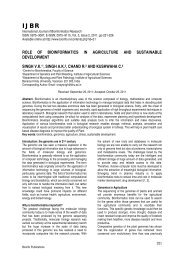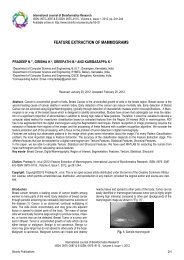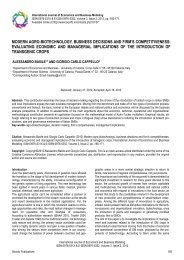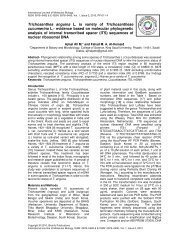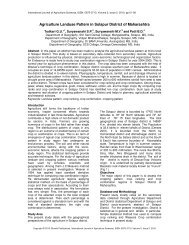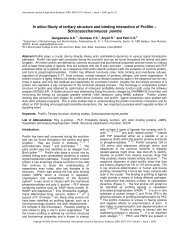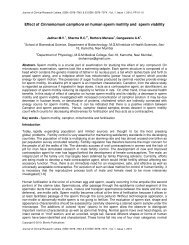role of co-operative sugar factories in rural - Bioinfo Publications
role of co-operative sugar factories in rural - Bioinfo Publications
role of co-operative sugar factories in rural - Bioinfo Publications
Create successful ePaper yourself
Turn your PDF publications into a flip-book with our unique Google optimized e-Paper software.
ROLE OF CO-OPERATIVE SUGAR FACTORIES IN RURAL DEVELOPMENT : A CASE STUDY<br />
OF DAMAJI SUGAR FACTORY, MANGALWEDA<br />
TODKARI G.U.<br />
International Journal <strong>of</strong> Agriculture Sciences<br />
ISSN: 0975-3710 & E-ISSN: 0975–9107, Volume 4, Issue 1, 2012, pp-168-171<br />
Available onl<strong>in</strong>e at http://www.bio<strong>in</strong>fo.<strong>in</strong>/<strong>co</strong>ntents.php?id=26<br />
Dept. <strong>of</strong> Geography, Shri Sant Damji Mahavidyala Mangalweda, Dist-Solapur, MS, India.<br />
*Correspond<strong>in</strong>g Author: Email- gov<strong>in</strong>dtodkari@gmail.<strong>co</strong>m<br />
Received: December 21, 2011; Accepted: January 12, 2012<br />
Abstract- Sugar <strong>in</strong>dustry occupies an important position on the <strong>in</strong>dustrial map <strong>of</strong> the state <strong>of</strong> Maharashtra. These <strong>factories</strong> played a major<br />
<strong>role</strong> <strong>in</strong> the socio-e<strong>co</strong>nomic development <strong>of</strong> <strong>rural</strong> areas <strong>in</strong> Maharashtra. The growth <strong>of</strong> various urban centers is help<strong>in</strong>g to solve the problem <strong>of</strong><br />
unemployment by provid<strong>in</strong>g employment <strong>in</strong> the grow<strong>in</strong>g <strong>in</strong>dustries and bus<strong>in</strong>ess. For the present <strong>in</strong>vestigation Damaji <strong>co</strong>-<strong>operative</strong> Sugar<br />
Factory is selected. Mangalwedha is located <strong>in</strong> drought prone area but Bhima river flows <strong>in</strong> these region. The Bhīma river catchment are favorable<br />
for <strong>sugar</strong> cultivation. Rema<strong>in</strong><strong>in</strong>g drought area is large than irrigation area, drought area <strong>sugar</strong> factory be<strong>co</strong>me key factor <strong>of</strong> development<br />
and employment. In this <strong>in</strong>vestigation primary and se<strong>co</strong>ndary data are used. Such type <strong>of</strong> study represents real the <strong>role</strong> <strong>of</strong> <strong>co</strong>-<strong>operative</strong><br />
<strong>sugar</strong> factory <strong>in</strong> <strong>rural</strong> <strong>of</strong> Mangalwedha and helps to planners, agricultural scientists and research scholars.<br />
Keywords - health camps, e<strong>co</strong>nomic activities, beautification, social responsibility, Agricultural family<br />
Citation: Todkari G.U. (2012) Role <strong>of</strong> Co-<strong>operative</strong> Sugar Factories <strong>in</strong> Rural Development : A case study <strong>of</strong> Damaji Sugar Factory, Mangalweda.<br />
International Journal <strong>of</strong> Agriculture Sciences, ISSN: 0975-3710 & E-ISSN: 0975–9107, Volume 4, Issue 1, 2012, pp-168-171.<br />
Copyright: Copyright©2012 Todkari G.U. This is an open-access article distributed under the terms <strong>of</strong> the Creative Commons Attribution<br />
License, which permits unrestricted use, distribution, and reproduction <strong>in</strong> any medium, provided the orig<strong>in</strong>al author and source are credited.<br />
Introduction<br />
The <strong>sugar</strong> <strong>factories</strong> be<strong>in</strong>g agro-based process<strong>in</strong>g units, are located<br />
near the supply <strong>of</strong> raw material namely <strong>sugar</strong>cane. These <strong>in</strong>dustrial<br />
units get located ma<strong>in</strong>ly <strong>in</strong> the <strong>rural</strong> areas and at tahsil or district<br />
centers. With the location <strong>of</strong> these process<strong>in</strong>g units <strong>in</strong> the <strong>rural</strong><br />
areas it is visualized that these <strong>factories</strong> can be the most appropriate<br />
agents for br<strong>in</strong>g<strong>in</strong>g about <strong>rural</strong> <strong>in</strong>dustrialization and change.<br />
The agro-based <strong>sugar</strong> <strong>factories</strong> with active Government aid and<br />
en<strong>co</strong>uragement led to <strong>in</strong>dustrial dispersal <strong>in</strong> the state like Maharashtra.<br />
Along with dispersal <strong>of</strong> <strong>in</strong>dustrialization these <strong>factories</strong><br />
due to their l<strong>in</strong>kage effects became the growth centers for <strong>rural</strong><br />
development.<br />
Sugar <strong>co</strong>-<strong>operative</strong> for their expansion gave importance to better<br />
<strong>sugar</strong>cane production, supply <strong>of</strong> appropriate agricultural <strong>in</strong>puts to<br />
farmers and <strong>in</strong>creased irrigation facilities <strong>in</strong> their area <strong>of</strong> operation.<br />
In addition growth <strong>of</strong> educational facilities, medical facilities, etc.<br />
were also undertaken as a part <strong>of</strong> area development by these <strong>co</strong><strong>operative</strong>s<br />
sled to growth <strong>of</strong> ancillary units, like paper plants, distillery<br />
units etc. which <strong>in</strong> turn <strong>in</strong>creased employment and led to further<br />
<strong>in</strong>dustrial development <strong>in</strong> the <strong>rural</strong> areas. The success <strong>of</strong> <strong>sugar</strong> <strong>co</strong><br />
-<strong>operative</strong>s <strong>in</strong> their <strong>co</strong>mmitment to area development led to growth<br />
International Journal <strong>of</strong> Agriculture Sciences<br />
ISSN: 0975-3710 & E-ISSN: 0975–9107, Volume 4, Issue 1, 2012<br />
<strong>of</strong> other agro-based process<strong>in</strong>g units like dairy <strong>co</strong>-<strong>operative</strong>s, sp<strong>in</strong>n<strong>in</strong>g<br />
mills, fruit process<strong>in</strong>g units and such agro based <strong>in</strong>dustrialization<br />
helped <strong>in</strong> the development <strong>of</strong> agriculture and brought about the<br />
necessary transformation <strong>of</strong> the <strong>rural</strong> areas and <strong>in</strong> the process the<br />
benefits <strong>of</strong> these activities reached the farmers and they too benefited<br />
and progressed. Such process <strong>of</strong> <strong>rural</strong> transformation and<br />
change is very noticeable <strong>in</strong> western Maharashtra and more so <strong>in</strong><br />
Solapur district where the <strong>co</strong>-<strong>operative</strong> <strong>sugar</strong> <strong>factories</strong> have <strong>in</strong>deed<br />
be<strong>co</strong>me the ‘Growth Centers’ for <strong>rural</strong> development.<br />
Objectives<br />
To asses the employment opportunity <strong>in</strong> <strong>sugar</strong> <strong>factories</strong>.<br />
To illustrate the <strong>role</strong> <strong>of</strong> <strong>co</strong>—<strong>operative</strong> <strong>sugar</strong> <strong>factories</strong> <strong>in</strong> <strong>rural</strong><br />
development.<br />
To suggest the re<strong>co</strong>mmendation for the development <strong>of</strong> <strong>sugar</strong><br />
factory.<br />
Study area<br />
‘Shri Sant Damaji Co-<strong>operative</strong> Sugar Factory, Mangalwedha’ is<br />
situated <strong>in</strong> northern side <strong>of</strong> Mangalwedha city. Shri Sant Damaji Co<br />
-<strong>operative</strong> Sugar Factory Ltd Mangalwedha has started its first<br />
Bio<strong>in</strong>fo <strong>Publications</strong> 168
Role <strong>of</strong> Co-<strong>operative</strong> Sugar Factories <strong>in</strong> Rural Development : A case study <strong>of</strong> Damaji Sugar Factory, Mangalweda<br />
crush<strong>in</strong>g season on 10th June, 1991 with low produc<strong>in</strong>g and crush<strong>in</strong>g<br />
capacity. It is bordered by the Pandharpur tahsil on the whole <strong>of</strong><br />
the northern side, by the Bathan on the east by the Bharmapuri on<br />
the south -east and Mangalwedha city on the south by the Sangola<br />
tahsil on the west. The study region i.e. Mangalwedha tahsil is one<br />
<strong>of</strong> the tahsil <strong>of</strong> Solapur district. It lies between 18 ° North latitude<br />
and 76 ° East longitude . The total area <strong>of</strong> the study region is<br />
about 1141.13 sq.km. Which is 7.62 percent <strong>of</strong> the Solapur district,<br />
<strong>co</strong>nsist <strong>of</strong> eighty one villages. Ac<strong>co</strong>rd<strong>in</strong>g to geographical area,<br />
Mangalwedha tahsil is tenth number tahsil <strong>in</strong> Solapur District.<br />
Database & Methodology<br />
For the present <strong>in</strong>vestigation primary data and se<strong>co</strong>ndary data are<br />
used. The primary data is <strong>co</strong>llected through <strong>in</strong>terviews, schedule<br />
and questioners. The se<strong>co</strong>ndary data are <strong>co</strong>llected from annual<br />
<strong>sugar</strong> factory report and Damaji Sugar Factory Office. The <strong>co</strong>llected<br />
data are represented by us<strong>in</strong>g various statistical and cartographic<br />
techniques.<br />
F<strong>in</strong>d<strong>in</strong>g & Discussion<br />
The <strong>co</strong>-<strong>operative</strong> <strong>sugar</strong> factory is established <strong>in</strong> a <strong>rural</strong> sett<strong>in</strong>g it<br />
be<strong>co</strong>mes possible for the organization to help generate various<br />
ancillary activities for the benefit <strong>of</strong> local farmers and other member<br />
<strong>of</strong> <strong>rural</strong> society. Sugar <strong>co</strong>-<strong>operative</strong> provides the basis for organization<br />
other e<strong>co</strong>nomic activities such as modern poultries, dairies,<br />
irrigation schemes, banks, goober gas plants, better breed<strong>in</strong>g <strong>of</strong><br />
<strong>co</strong>ws and many other such activities which <strong>co</strong>ntribute largely to the<br />
betterment <strong>of</strong> the e<strong>co</strong>nomic <strong>co</strong>nditions not only <strong>of</strong> the farmers but<br />
also landless labourers and other people <strong>in</strong> the area. The factory<br />
also establishes school, heath centers for medical facilities with<br />
modern hospitals and dispensaries and organizes various cultural<br />
and sports activities. A <strong>co</strong>nsiderable amount is set apart by many<br />
<strong>co</strong>-<strong>operative</strong> <strong>factories</strong> to make the life <strong>of</strong> the local <strong>in</strong>habitants more<br />
purposeful and mean<strong>in</strong>gful. Thus diversification <strong>of</strong> production activities<br />
leads to a process <strong>of</strong> <strong>rural</strong> <strong>in</strong>dustrialization which also is<br />
employment generat<strong>in</strong>g.<br />
International Journal <strong>of</strong> Agriculture Sciences<br />
ISSN: 0975-3710 & E-ISSN: 0975–9107, Volume 4, Issue 1, 2012<br />
Lift Irrigation Scheme-The Shree Sant Damaji Co-<strong>operative</strong> Sugar<br />
Factory Ltd Mangalwedha has sponsored the lift irrigation<br />
schemes with a view to <strong>in</strong>crease the land under <strong>sugar</strong>cane and to<br />
fulfill the needs <strong>of</strong> basic raw material, i.e. <strong>sugar</strong>cane with<strong>in</strong> the<br />
<strong>co</strong>mmand area. Lift irrigation schemes is <strong>in</strong> the area are formed<br />
ma<strong>in</strong>ly due to the keen <strong>in</strong>terest shown by <strong>co</strong>-<strong>operative</strong> <strong>sugar</strong> factory<br />
gives guarantee to the banks for extend<strong>in</strong>g loans for irrigation<br />
schemes.<br />
Development <strong>of</strong> Sugarcane- Crush<strong>in</strong>g capacity <strong>of</strong> the factory is<br />
2500 metric tones. As factory crush<strong>in</strong>g season is <strong>of</strong> 223 days there<br />
is necessity <strong>of</strong> 600000 metric tones <strong>of</strong> <strong>sugar</strong>cane for good quality<br />
and high production <strong>of</strong> <strong>sugar</strong>. In work<strong>in</strong>g field and the variety <strong>of</strong><br />
seedl<strong>in</strong>g used are Kosi 671, Co 94012, Co 86032 and the VSI 434,<br />
VSI 435 etc produced by tissue culture technology by <strong>co</strong>mpany VSI<br />
for per acre <strong>in</strong>crement <strong>in</strong> <strong>sugar</strong> production. These different programmes<br />
are organised by factory for the farmers.<br />
Supply <strong>of</strong> Good Quality Sugarcane Seeds-The factory has been<br />
supply<strong>in</strong>g the standard seed <strong>of</strong> <strong>sugar</strong>cane on its own <strong>co</strong>st to cane<br />
producer. The <strong>sugar</strong>cane seed is brought from famers. Similarly,<br />
the supply <strong>of</strong> seeds is also made available on credit from the seed<br />
plots <strong>of</strong> the other producers. Factory has supplied various types <strong>of</strong><br />
<strong>sugar</strong>cane seeds i-e CO 671, Co 86032, to the member farmers.<br />
The Shri Sant Damaji Co-<strong>operative</strong> Sugar Factory has supplied<br />
<strong>sugar</strong>cane seed to farmer members. After the year 2005 more and<br />
more farmers have taken the benefits <strong>of</strong> cane seeds. From the<br />
year 2005-06 <strong>sugar</strong> factory expend 2 lakhs on cane seed programme.<br />
And <strong>in</strong> the year 2006-07 factory expand 1.54 lakhs on<br />
<strong>sugar</strong>cane seeds. In recent year more farmers have taken benefit<br />
<strong>of</strong> <strong>sugar</strong>cane seeds.<br />
The beautification <strong>of</strong> factory site- From last one and half years<br />
nearly 1700 trees have been planted not only to <strong>co</strong>ntrol pollution<br />
but also to give shadow <strong>of</strong> love to members. It <strong>in</strong>cludes different<br />
types <strong>of</strong> Mango ,Nilgiri, Alphonso, Ashoka along with it <strong>co</strong><strong>co</strong>nut,<br />
and Chikku etc. cash trees also planted. For the beautification <strong>of</strong><br />
the campus various trees are planted e.g. Tamar<strong>in</strong>d, Bottle palm,<br />
Chapa, Silver oak, Gulmohor etc. The Golden Duranda is grown on<br />
3500 feet on the factory site to de<strong>co</strong>rate the campus.<br />
Accident Insurance for factory members- The factory has made<br />
resolution <strong>in</strong> its meet<strong>in</strong>g accident <strong>in</strong>surance for the members nearly<br />
14240 members <strong>in</strong>surance would be the beneficiary <strong>of</strong> it. Nearly<br />
fourteen members have got benefit <strong>of</strong> this accident <strong>in</strong>surance. Life<br />
Insurance Corporation <strong>of</strong> India is provid<strong>in</strong>g these facilities to factory.<br />
Help<strong>in</strong>g hand to heirs <strong>of</strong> martyr- Out <strong>of</strong> social ac<strong>co</strong>untability, the<br />
factory used to help to the heir <strong>of</strong> the martyr, who dies on the border<br />
<strong>of</strong> the nation. The help is <strong>in</strong> the form <strong>of</strong> money. The amount is<br />
up to 1 lakh. This help is not only given to factory members but<br />
given to them also, who are not member .The factory has donated<br />
to Mukhyamantri Sahayyata Nidhi for earth quake affected people.<br />
In the year 2000-01factory funded 100000 to Government.<br />
Agriculture exhibition To give advanced knowledge and <strong>in</strong>formation<br />
<strong>of</strong> agricultural to the farmers, factory used to organize agri-<br />
Bio<strong>in</strong>fo <strong>Publications</strong> 169
culture exhibition each and every year on the factory site. In this<br />
exhibition different stalls are <strong>in</strong>stalled e.g. agricultural technology,<br />
advanced equipments, fertilizers, seeds, animal husbandry, various<br />
government schemes etc. Many farmers visit and implement the<br />
th<strong>in</strong>gs <strong>in</strong> their farms.<br />
Computer Tra<strong>in</strong><strong>in</strong>g to employees- In the 21 century, every th<strong>in</strong>g<br />
is <strong>co</strong>mputerized. Hence the factory has arranged <strong>of</strong> the facility <strong>of</strong><br />
<strong>co</strong>mputer tra<strong>in</strong><strong>in</strong>g to the <strong>of</strong>ficers and other workers. Today more<br />
than 300 <strong>of</strong>ficers and workers are <strong>co</strong>mputer literate.<br />
Cattle Camp- The factory has started the camp for the cattle’s<br />
belong<strong>in</strong>g to drought stricken area <strong>of</strong> the factory. Out <strong>of</strong> social responsibility<br />
the factory has started cattle camp on 2 Sept. 2003 to<br />
save live stock. It was run for 10 months and almost more than<br />
2000 cattle’s were kept <strong>in</strong> the camp. Factory expands 25 lakh on<br />
these cattle camp.<br />
Shopp<strong>in</strong>g centre- In the age <strong>of</strong> IT <strong>co</strong>mpetitor the question <strong>of</strong> employment<br />
became very severe <strong>in</strong> front <strong>of</strong> the <strong>rural</strong> youth also. The<br />
factory has decided to build shopp<strong>in</strong>g centre and make it available<br />
to the unemployed <strong>rural</strong> youth. It will help the <strong>rural</strong> youth for get the<br />
work to their hands.<br />
The safe <strong>of</strong> fruit-bear<strong>in</strong>g trees to farmers- To improve the f<strong>in</strong>ancial<br />
<strong>co</strong>ndition <strong>of</strong> the farmers, the factory has started the scheme <strong>of</strong><br />
provid<strong>in</strong>g the fruit - bear<strong>in</strong>g trees to the farmers. This scheme was<br />
started <strong>in</strong> the year 2002-03. In the year 2002-03 factory had supplied<br />
1120. Fruit plants on no pr<strong>of</strong>it and no loss basis and the <strong>co</strong>st<br />
<strong>of</strong> plants was Rs15590. In the year 2004-05 farmers took 515 fruit<br />
plants from the factory the <strong>co</strong>st <strong>of</strong> which was Rs7770. After the<br />
year 2004-05 the number <strong>of</strong> fruit plants supplied has <strong>in</strong>creased.<br />
Thus the Shri Sant Damaji Co-<strong>operative</strong> Sugar Factory is mak<strong>in</strong>g<br />
its attempts to develop fruit plantation and thus <strong>in</strong>crease the greenery<br />
<strong>in</strong> its area <strong>of</strong> its area <strong>of</strong> operation.<br />
Sugar distribution to members- The factory Board <strong>of</strong> Director<br />
decided to distribute <strong>sugar</strong> to the members 5 kilograms per year on<br />
<strong>co</strong>ncessional rate.<br />
Sugar Factory School- The <strong>sugar</strong> school is started near factory<br />
site with the help <strong>of</strong> <strong>sugar</strong> <strong>co</strong>mmission for the children <strong>of</strong> <strong>sugar</strong>cane<br />
cutter labours. Factory gives the tra<strong>in</strong><strong>in</strong>g to teachers <strong>in</strong> <strong>co</strong>llaboration<br />
with ‘Aastitva prakashan’ Pune. Factory provides all the<br />
educational aids to all the children which are admitted <strong>in</strong> the <strong>sugar</strong><br />
factory school. In the year 2006-2007, 150 children get benefits <strong>of</strong><br />
it.<br />
Felicitation <strong>of</strong> Meritorious students- The students who embark<br />
their names <strong>in</strong> Merit list <strong>of</strong> H.S.C. and S.S.C. exams belongs to<br />
Agricultural family. These students are felicitated by factory every<br />
year. The factory used to give <strong>in</strong>spiration to the meritorious students<br />
by felicitat<strong>in</strong>g them.<br />
Response to emergencies- Dur<strong>in</strong>g emergencies and natural calamities<br />
the resources <strong>of</strong> the factory prove extremely useful for<br />
organiz<strong>in</strong>g relief and other activities. On all such occasions the<br />
leaders and shareholders have <strong>co</strong>ntributed generously. The Gov-<br />
Todkari G.U<br />
International Journal <strong>of</strong> Agriculture Sciences<br />
ISSN: 0975-3710 & E-ISSN: 0975–9107, Volume 4, Issue 1, 2012<br />
ernment department have now realized the importance <strong>of</strong> the <strong>factories</strong><br />
<strong>in</strong> the life <strong>of</strong> the local people and have there for been rely<strong>in</strong>g<br />
<strong>in</strong>creas<strong>in</strong>gly on their help and <strong>co</strong>-operation. It is such easier and<br />
more effective on mobilize people for relief work when the leaders<br />
and shareholders voluntarily decide to do so <strong>in</strong>stead <strong>of</strong> on the diktat<br />
<strong>of</strong> a Government <strong>of</strong>ficial.<br />
Supply <strong>of</strong> Molasses- Molasses has be<strong>co</strong>me a very valuable raw<br />
material for the chemical <strong>in</strong>dustry. It is also used as fertilizer <strong>in</strong>to<br />
field as well as for the burn<strong>in</strong>g <strong>co</strong>ke. Molasses is a good for the<br />
fields grow<strong>in</strong>g <strong>sugar</strong>cane. .In the year 2000-01 farmers had taken<br />
22500 tones <strong>of</strong> molasses. The rate <strong>of</strong> molasses was Rs. 1333.33<br />
per tone. In the year 2006-07 farmers took 20444.760 tones <strong>of</strong><br />
molasses and the rate was Rs 2006 per tone. The molasses is<br />
used for fuel purpose and also as manure <strong>in</strong> the farms.<br />
Road Construction- Efforts have been made by the <strong>sugar</strong> factory<br />
for the development <strong>of</strong> roads. This process has helped to build up<br />
<strong>in</strong>frastructural facility <strong>in</strong> the <strong>rural</strong> areas. For accelerat<strong>in</strong>g the<br />
transport <strong>of</strong> harvested cane to factory from the fields, the <strong>sugar</strong> <strong>co</strong><strong>operative</strong><br />
has built up approach road <strong>in</strong> its area <strong>of</strong> operation. Sugar<br />
factory has been <strong>co</strong>nstruct<strong>in</strong>g cross ways across the river and<br />
streams by us<strong>in</strong>g home pipe to reduce the distance between the<br />
<strong>factories</strong> and the area <strong>of</strong> harvest<strong>in</strong>g. Government grants are made<br />
available to the factory to make use <strong>of</strong> the bulldozers for road level<strong>in</strong>g<br />
purpose. As a result <strong>of</strong> these efforts made by the <strong>sugar</strong> factory,<br />
the <strong>sugar</strong> factory <strong>in</strong> turn gets the benefit <strong>of</strong> the higher re<strong>co</strong>very <strong>of</strong><br />
harvested cane duke to quick transportation <strong>of</strong> cane to the factory<br />
for crush<strong>in</strong>g. The above table gives details <strong>of</strong> the expenditure <strong>of</strong><br />
road <strong>co</strong>nstruction. In 2006-07, there was Rs18000 expenditure on<br />
road <strong>co</strong>nstruction and <strong>in</strong> the year 2006-07, Rs 27000 expenditure<br />
was <strong>in</strong>curred on road <strong>co</strong>nstruction. Shri Sant Damaji Co-<strong>operative</strong><br />
Sugar Factory Ltd., Mangalwedha has built up some approach<br />
roads <strong>in</strong> the area <strong>of</strong> operation as below.<br />
Labour Welfare Programme- There is good relation between<br />
workers and the management from the <strong>in</strong>ception <strong>of</strong> the <strong>co</strong><strong>operative</strong><br />
<strong>sugar</strong> factory. Factory is always ready to solve all labour<br />
problems. Sugar factory sends the workers for tra<strong>in</strong><strong>in</strong>g and sem<strong>in</strong>ars.<br />
The facilities <strong>of</strong> <strong>in</strong>door and outdoor games have been provided<br />
by the Shri Sant Damaji Co-<strong>operative</strong> Sugar Factory. These<br />
activities <strong>in</strong>clude volleyball, carom, chess, table tennis, cricket etc.<br />
The factory canteen is run on private basis. Tea, Snakes, meals<br />
etc., are served <strong>in</strong> the canteen. Factory has established a good<br />
modern <strong>co</strong>lony on factory site for workers and their family members.<br />
One health centre is <strong>in</strong> the premises <strong>of</strong> the factory with a<br />
qualified Medical Officer and requisite staff. All workers <strong>of</strong> the factory<br />
and their family and harvest<strong>in</strong>g workers are giv<strong>in</strong>g medical<br />
treatment <strong>of</strong> <strong>co</strong>ncessional rates. Library facility with book <strong>of</strong> well<br />
known writers is available for the workers and families resid<strong>in</strong>g at<br />
the factory site. The dailies, and Magaz<strong>in</strong>es which are widely popular<br />
<strong>in</strong> Maharashtra are made available for read<strong>in</strong>g purpose and the<br />
workers take the benefit <strong>of</strong> it. It is the factory’s pride and honor that<br />
the marg<strong>in</strong>al amount <strong>of</strong> bonus (20 percent) are paid to the factory<br />
workers.<br />
Medical Facility- The Shri Sant Damaji Co-<strong>operative</strong> Sugar Factory<br />
organized camps. The factory organizes health camps for vari-<br />
Bio<strong>in</strong>fo <strong>Publications</strong> 170
Role <strong>of</strong> Co-<strong>operative</strong> Sugar Factories <strong>in</strong> Rural Development : A case study <strong>of</strong> Damaji Sugar Factory, Mangalweda<br />
ous diseases <strong>of</strong> the eye, teeth, sk<strong>in</strong>, child health, cancer etc. In<br />
these camps expert doctors <strong>in</strong> the respective fields are called and<br />
the treatment is given free <strong>of</strong> charges to the patients. If needed<br />
operations are done and some cast is borne by the <strong>co</strong>-<strong>operative</strong><br />
<strong>sugar</strong> factory. In the year 2001 to 2007 these camps were organized<br />
and 4030 persons took benefit <strong>of</strong> the facility<br />
Conclusion<br />
Shri Sant Damaji Co-<strong>operative</strong> Sugar Factory is situated <strong>in</strong><br />
Uchethan and established <strong>in</strong> 1991. This <strong>sugar</strong> factory is affected<br />
on catchment area with various ways. Various schemes have<br />
adopted by <strong>sugar</strong> factory for the surround<strong>in</strong>g <strong>rural</strong> area development.<br />
In which Agriculture exhibition, Computer Tra<strong>in</strong><strong>in</strong>g to employee,<br />
Cattle Camp, Felicitation <strong>of</strong> Meritorious students, Response<br />
to emergencies, Supply <strong>of</strong> Molasses, supply <strong>of</strong> good quality<br />
<strong>sugar</strong>cane seeds, Accident <strong>in</strong>surance, Sugar factory school,<br />
Labour Welfare programs etc. are <strong>in</strong>cluded. But <strong>co</strong>generation and<br />
distillery project are not started <strong>in</strong> this factory which can give large<br />
pr<strong>of</strong>it and create more employment opporchnity.<br />
References<br />
[1] Annual Report <strong>of</strong> Shri Sant Damaji Co-<strong>operative</strong> Sugar Factory<br />
Ltd., Mangalwedha.2009/10<br />
[2] Mohite.Y.J. Sugar Industry <strong>in</strong> Maharashtra.<br />
[3] Bhanje B.M. (1995) Sugar Co-<strong>operative</strong> And Rural Transformation.<br />
A Geographical Perspective <strong>of</strong> the Command Area <strong>of</strong><br />
Warana Sugar Factory’, Unpublished Ph.D. thesis,<br />
(Geography) Shivaji University, Kolhapur.<br />
[4] Inamdar N.R. (1973) Government and Co-<strong>operative</strong> Sugar<br />
Factory.<br />
[5] S<strong>in</strong>gh G.B. (1979) Transformation <strong>of</strong> Agriculture.<br />
[6] Das B.N. and Sarkar A.K. (1972) Rural area Development<br />
Karnal Area.<br />
[7] More K.S. (1980) Chang<strong>in</strong>g Pattern <strong>of</strong> Agriculture Landaus In<br />
Kolhapur District (Maharashtra)’ unpublished Ph.D thesis,<br />
Shivaji University, Kolhapur.<br />
International Journal <strong>of</strong> Agriculture Sciences<br />
ISSN: 0975-3710 & E-ISSN: 0975–9107, Volume 4, Issue 1, 2012<br />
Bio<strong>in</strong>fo <strong>Publications</strong> 171


